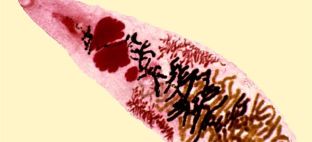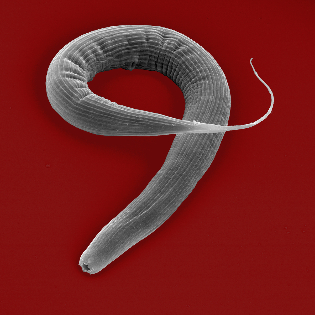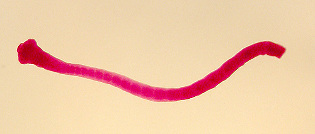Opisthorchiasis - a disease from the group of helminths that infest the liver and pancreas. In the world has about 21 million people infected with liver flukes. Giardiasis. Widespread protozoan disease during which may vary from subclinical to severe forms and arises because of the infection. Disease with worms, caused by the pig tapeworm. Diseases from the group of helminths that infest the liver and pancreas.

Types of parasites
Only a person with medical education know all kinds of parasites in the human body. A large part of which constitutes a danger to health. Despite the fact that a long time some diseases can be the cause of serious complications.
Parasites in the body of adults and children
Not everyone knows what will occur parasites and where they inhabit. From this disease suffer from individuals of all ages. To the parasites of man include the following organisms:
- the fungus (yeast);
- deworming (hookworms, cestodes, trematodes);
- the simplest (single-celled);
- mites;
- lice;
- bedding bed bugs;
- the larvae of various insects.
All distinguishes one property: they lead a parasitic way of life, it is alive and growing at the expense of the person. Life varies according to the length. Some parasites may occur in the body of the people from 20-30 years without specific clinical pictures. There is a classification of the parasites according to their habitats. Most often affects the skin veils the person. Such organisms are called ectoparazitia. These include bedbugs, lice, a lot of mold and dust mites. Data beings can live in the internal organs, lymph vessels and muscles. Represent a great danger, due to the possibility of destruction of the soft tissues.
Types of parasites depending on the localization of

Some helminths live in the liver. These include Fluke, Fasciola Hepatica, Echinococcus roundworm, toxocariasis. There are kinds of worms live in the lungs. This group includes ascaris, Echinococcus, representatives of the nematodes, activators of paragonimoz. Some helminths can be placed in the bile (cat Fluke, Fasciola Hepatica). Sometimes in the process to engage the muscles. It is observed in the infestation of trichinosis. Less often affects the kidneys and urinary track. To the parasites who are living in these bodies, belongs to shistosoma. Often helminths are found in the blood and lymph vessels. Parasites attack mainly the skin veils. Possible involvement in the process of mucus. The most common are diseases, such as scabies, pain, wardrobe, and pubic lice, candidiasis. Lice feed on the blood of humans, causing itching. Occur on the scalp, in the pubic area and on the inner layer of clothing, which is adjacent to the body.
As the parasites penetrate into your body man?
You need to know not only information about what kinds of parasites are found in humans, but also how goes the assault. Most often a person infected go unnoticed. It happens in domestic conditions helena in the conduct of professional activities, when working on the land, when in contact with domestic pets (cats, dogs, rodents). The development of intestinal parasites occurred during the ingestion of the ova helena larvae worming through the mouth. This happens when the consumption of contaminated food, tainted meat helena fish, as well as through dirty hands. People become infected mainly fecal-oral mechanism. Less often occurs contact transmission when parasites are introduced into the skin. Is it possible, when the scabies, všie, mycosis, on strongyloidiasis, the hookworm.
The parasites are transmitted with food (meat, fish, vegetables, fruit, herbs, forest fruits), raw water, dirty hands and on the ground. There helminths, and protozoa that fall into the human your body through contact with contaminated feces animal hair. Some parasitic worms in the form of eggs and protozoa microorganisms are transmitted via insects and ticks. The vector may be mosquitoes, mosquitoes, flies. We distinguish between parasites that are able to be transmitted during a sexual intercourse. This group includes Trichomonas, mold, pubic lice. Of great importance are the entities, which penetrate from one person to another directly through the skin and are able to live in a person for a longer period of time. So going on the infection - a disease caused by a high-towering above the tapeworm, which lives in the small intestine of man.

Representatives of the group of ectoparasites
It is necessary to know not only the kinds of dangerous creatures, but also which of them are capable of living on human skin. Very common is a disease, such as lice. It becomes a pain, a and pubic. The originator of the — louse. These parasites attack the skin of the veil and their appendages (hair). Head lice are most commonly detected in childhood. Causes — close contact with other children, failure to comply with the rules of personal hygiene and the density of the bands. Lice have the following characteristics:
- are ectoparazitia (they live on the surface of the human your body);
- feed on blood;
- cause itching of the skin;
- size from 0.4 to 6 mm;
- they live for about a month;
- they have high fertility;
- are sensitive to high temperatures;
- they have piercing-sucking oral apparatus.
During the inspection of patients often identified lice eggs (nits). Are firmly attached to the hair and have small dimensions. The symptoms of head lice more frequently detected in children aged from 15 to 24 years. Pubic lice are to a greater extent affect the young people. Issue the following risk factors for infection with lice:
- stay in kindergartens, boarding schools and shelters;
- bad socio-domestic conditions;
- availability in the family sick;
- work in kindergartens;
- wearing foreign clothes;
- visit public places (saunas, spas, hairdressers);
- the rare washing laundry.

Often they occur as parasites in the human body, as itching of the pliers. They are easily transmitted from sick to healthy in contact. The risk group includes persons who have one single bed and foreign objects of personal hygiene. Itching forceps have a gnaw of the oral apparatus. They live under the skin, feeding the epidermis. These parasites cause allergic reactions and rashes. The most commonly affected skin on the abdomen, breasts, thighs and the gaps between the fingers. The creatures are most active at night, so the symptoms of the disease (itchy skin), are usually expressed in the evening and at night.
Worms in the intestines of man
Not everyone knows the kinds of parasitic worms. Is divided on hookworms (round worms), cestodes (tapeworms) and trematodes (gill). Many helminths live in the human gut. A prime representative of this group of endoparasites is Ascaris. These helminths live in the small intestine. The larvae can get into other organs (liver, lungs). The occurrence in the world reaches 85 cases per 100 thousand people. The most frequently sick small children. Parasites in the form of eggs fall into the intestine when consuming inadequately washed products. Roundworm have the following characteristics:
- have a round long body about the size to 40 cm;
- belongs to geohelminths (partially develop in the environment);
- lay up to 240 thousand eggs per day.
The sick person along with the feces excreted a large amount of eggs. They fall into the external environment and some time to ripen. The availability of this worm in the body can lead to inflammation of the mucous membrane of the intestine and to the development of obstruction. To the group of intestinal helminths included helminthiasis from the group nematosis caused by worms of the species of roundworms. Representatives are pinworms. These parasites live in the small and large intestine, often this has led to a dysbacteriosis, on enteritis. Pinworms — small (up to 1 cm) worms of white paint. They have a sharpened end, with the help of which are fixed on the mucous membranes. Live data helminths in 2 months. To the group of risk includes organised children visiting the children's garden and the lower classes of the school. Infection occurs the landlord helena food way. Transfer factors are the hands, toys, equipment, products, stationery. The parasites have the ability to crawl out to lay eggs. It happens mostly at night. The main signs of the presence of pinworms in the body, are: abdominal pain, disturbances stool and itching in the anus.

Protozoa, parasites of man
Only doctors know species of parasitic protozoa. Their huge amount. The most commonly occur following a single-celled:
- amoebas;
- balantidia;
- Trichomonas;
- Leishmania;
- Cryptosporidium;
- giardia;
- malaria Plasmodium;
- Toxoplasma;
- Trypanosoma.
Between protozoosis most common giardiasis. It is a disease caused by the past conduct of single-celled microorganisms, with beneficial losing 12-earthy intestine and liver. The causative agent of the disease — Giardia. Parasites of man of this type have the following characteristic features:
- are the past have carried out single-celled mikroorganizmi;
- they live in 2 forms (vegetative and spore);
- are transmitted through food, water, utensils and items of daily needs;
- are carried by insects;
- affecting mainly children under 10 years of age;
- about the size of up to 21 µm (vegetative forms);
- they have flagella (vegetative forms);
- they are able to move actively.
These creatures are very resistant in the environment. Injection of a person occurs water, alimentary helena contact-domestic ways. People are infected with cysts of Giardia. The peak incidence falls on the spring and summer seasons. Giardia common everywhere. At risk groups include children attending organized groups. More likely to fall ill persons who are not trained in the simple skills for personal hygiene. Often they are in the examination of patients to draw attention to this micro-organism, like the amoeba. It is a kind of protozoa. Beings struck by the intestine and may contribute to the formation of abscesses in other organs (liver). These parasites are more often found in people who regularly wash their hands. The amoeba lives in the form of trophozoites and cysts. The latest stable in the environment. The groups at risk for amebiasis are people with immunodeficiency, as well as pregnant. In addition to amoebas and Giardia in humans can identify of Cryptosporidium oocysts. It microbes, parasitic in the intestines. Cryptosporidium cause diarrhea and other intestinal symptoms. Between the dangerous for people parasites include Plasmodium. Their intolerant mosquitoes. Infection occurs when insect bites.

The clinical manifestations of the presence of parasites
Get acquainted with the information about what parasites live in the intestines, it is necessary to know, and the main symptoms of diseases caused by them. Availability in the body of roundworms is characterized by a disorder of the chair according to the type of diarrhea, bloating, pain in the lower abdomen, itching in the perianal area, by irritability, rash, violation of appetite. Children with enterobiasis often get sick. Pinworms can become a cause of the development of gastroduodenitis, enteritis and dysbiosis. If in the body are roundworm, then people troubled by nausea, abdominal pain, anal itching, excessive items of saliva, decreased appetite, weakness. Simple ascariasis can become a cause of large bowel obstruction parasites the adults. In the phase of migration of larvae is possible the formation of acne and coughs. Allergic reactions and digestive disorders — these are the main symptoms of intestinal helminths. Some worms attack the muscles. Clear representatives are Trichinella. Cause muscle pain, allergic reactions and swelling. As parasites of humans, such as happiness, struck the authorities of the biliary system (the liver, the bladder and the pipe).
Manifested nausea, vomiting, low-grade temperature, pain in the hypochondrium on the right side. To beings living in the urinary bladder and the kidneys, include shistosoma. Cause dysuric phenomena. In the urine of these patients may be identified blood. Some parasites of man represent a great danger and over the years may not manifest itself. These include tapeworms. These tape worms are able to survive in the body only in the form of larvae. A person is the blockage of the branches for that particular helminth. Echinococcus, living in the liver helena the lungs, it forms bubbles (cysts). May be a few dozen. Head lice can cause patients itching and can be a cause of eczema, pyoderma, and chronic dermatitis. On the skin people the rash appears. The defeat of the man chesotocnami forceps characterized by skin itching mainly in the evening and night time and the rash. In the presence in the body of malaria parasites observed fever, chills, dizziness, nausea, jaundice, increasing liver and spleen.
The largest parasites of man

Some parasites are microscopic in size while others can reach a length of 20 m. the largest of them are:broad tapeworm (the causative agent of difillobotrioza), pig and bullish apni. These beings have narrow, flat body, cut into many segments (proglottid). The pig tapeworm reaches 4 meters in length. He has a head, body and fools. Observed and hooks. A person acts in a role of the final host.
Sometimes in the body of the people, parasitic larvae of this helminth. The biggest worm is bullish tapeworm. The length of his your body reaches 20 m. This parasite causes this disease, as the beef tapeworm infection. Large individuals are able to contend, which forms a tangle in the human gut. It can be a cause of a violation of the passage of the feces. Slightly smaller dimensions are helminths from the group of liver flukes (broad tapeworm). Assault them, maybe at the consumption of half-baked infected fish.
How to get rid of parasites? Not for a person more flour than you wish to restore the fact that under the influence of dangerous creatures health, but may not be able to do it. Individual therapy practically does not give good results. In the presence of the slightest symptoms need to seek medical help. Regardless of the type of parasites in humans, the doctor to accurately determine the diagnosis and select an effective treatment.






































